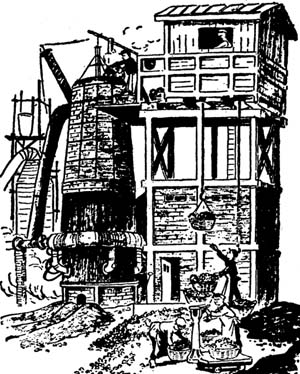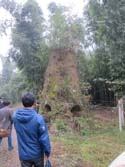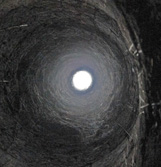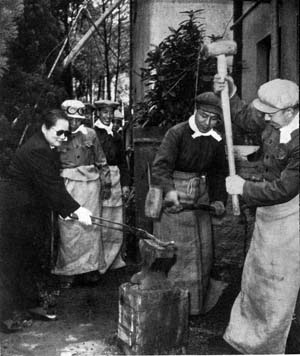Donald B. Wagner, Background to the Great Leap Forward in Iron and Steel
Click on any image to see it enlarged.
‘The Great Leap Forward in Iron and Steel’, 1958–60
| On the
campaign and the period see especially Roderick
MacFarquhar, The origins of the
Cultural Revolution,
vol. 2: The
Great Leap Forward,
Oxford 1983; Michael Schoenhals, Saltationalist
socialism: Mao Zedong and the Great Leap Forward
1958, Stockholm 1987;
—, ‘Yang Xianzhen’s Critique of the Great Leap
Forward’, Modern Asian
studies, 1992, 26.3:
591–608; S. A. Nikolayev & L. I. Molodtsova,
‘The present state of the Chinese iron and steel
industry’, Soviet geography:
Review and translation,
1960, 1.8: 55–71; R. Sewell, ‘A guide to the
Chinese steel industry’, The British
steelmaker, July 1960,
259–263; Robert R. Bowie
& John K. Fairbank, Communist China
1955–1959: Policy documents with analysis,
Cambridge, Mass., 1962; Harold C. Hinton, The People’s
Republic of China, 1949–1979, a documentary
survey, vol. 2: 1957–1965: The
Great Leap Forward and its aftermath,
Wilmington, Del. 1980. |
With the Communist assumption of power in 1949 came peace
after more than a decade of war and destruction. In its
first years the government was fully taken up with acute
problems: the rebuilding of agriculture and the most basic
infrastructure. Meanwhile the first steps were being
taken, with the help of the Soviet Union, toward the
establishment of modern industry – coal mines, steelworks,
oil refineries, and much more.
‘Gridlock’ problems gradually became apparent.
Development of China’s infrastructure (railroads,
highways, harbours, the electric power grid, etc.)
required steel in immense quantities, but production of
steel in the large-scale modern plants recommended by
Soviet advisers required a well-developed infrastructure.
Resources for investment in industry could only come from
agriculture, and in the Soviet Union under Stalin the
peasants’ surplus had been confiscated using hard methods.
But the Chinese peasants had very little surplus, and
furthermore Mao Zedong and most of his associates came
from peasant roots; they felt nothing like the hate and
contempt for the peasantry that had driven Stalin. Around
this time the political tension between China and the
Soviet Union began to show itself.
In response to this challenge the Planning Unit for
Ferrous Metallurgy under the Ministry of Metallurgical
Industry designed and built several ironworks with blast
furnaces of modern design but small size, typically 50–80
cubic metres. This is dimunitive compared to modern blast
furnaces of 1500–3000 cubic metres, but large compared
with the traditional blast furnaces – they were seldom
over 10 cubic metres, and for example in Dabieshan they
were around 0.4 cubic metres.
An engineering conference on the new small ironworks was
called in June 1957, and according to the final report the
participants were largely positive. Among the conclusions
was the following, on the choice of scale:
| Yejin bao,
1957.22: 18. |
In
the planning of a small blast furnace for a locality,
the scale of production should be set to satisfy local
needs; it should definitely not be nationally
oriented. Especially where the conditions for
transport of raw materials are not adequate, the scale
should not be too large. Many comrades proposed in
their contributions that the appropriate size for a
small blast furnace should be 30–50 cubic metres.
According to Comrade Tang Fumin, ‘preliminary analyses
and economic comparisons suggest that a planned blast
furnace of 80 cubic metres in a typical production
unit will require an investment of 25,000 yuan,
including the blast furnace itself and installation of
water, electric power, transportation, and facilities
for workers. A blast furnace of 50 cubic metres, on
the other hand, requires only 18,000 yuan, and
a blast furnace like those in Sichuan and Hunan, of
less than 30 cubic metres, requires about 13,000 yuan.
An industrial worker’s salary in this period was on the order of 50 yuan per month, so these investments were not at all small. The production units seem to have been plants with 20–30 workers, producing for a relatively large local market. The largest of the traditional blast furnace types, for example those in Sichuan and Hunan, could be used, but the emphasis was on larger and more modern plants. This was the strategy of the central government in early 1957, and even at a distance of 50 years it seems to have been appropriate for the conditions of the time.
In the provinces, however, there was still interest in
very small blast furnaces like the ones used in Dabieshan and Fujian. In isolated regions
this technology had never been forgotten, and it had begun
to thrive again after 1949. Obtaining iron and steel from
outside for local reconstruction required money and
political influence, both of which were in short supply in
the poorest regions. A continuation of the local iron
industry was perfectly natural. In the last months of 1958
a large number of brochures with technical descriptions of
the construction and operation of very small blast
furnaces were published by various provincial governments,
and these must have been under preparation from some time
in 1957. My description of the technology in Dabieshan is partly based
on one of these. The brochure states that an ironworks
which uses the technology it describes requires an
investment of ‘only’ several ten-thousands of yuan. Obviously this
refers to an industrial plant with numerous workers. At
this time no one was suggesting that the peasants should
go out and make iron in their backyards.
Some very large problems were ignored here. Most of the smallest blast furnaces were fuelled with charcoal, and increasing their production would necessarily lead to environmental destruction. And those which used mineral coal most often produced cast iron with a high sulphur content; this could be used in foundries, but it could not be converted to useable wrought iron or steel.
Politics now took an unfortunate turn. The happy days
that followed the revolution of 1949 gradually receded,
and criticism of the Communist Party by intellectuals
became strident. In 1957 the party responded with the
‘Anti-Rightist Campaign’, which in large part was a
campaign against experts. Engineers and economists who
warned against predictable consequences of some of the
party’s dispositions were demoted or fired; the last
bastions against ignorance or even stupidity fell.
Enthusiasm took command.
| Peking Review,
4 March, p. 8; 8 July, p. 8; 29 July, p. 12; 2
September, pp. 4, 6–7; 16 September, pp. 21–23;
30 September, pp. 13–15; 14 October, pp. 15–16;
21 October, pp. 3–4; 11 November, pp. 14–16; 18
November, p. 3; 30 December, pp. 6–9. |
Freed from the warnings of experts, the government’s
ambitions rocketed, as can be seen in the official
magazine Peking review
for the year 1958. The national economic plan for 1958
included the construction of 14 small and medium-sized
‘metallurgical projects’, to be administered by local
authorities. In April the Great Leap Forward was
announced: collectivization (the formation of communes
rather than cooperatives) was to be encouraged, and 13,000
small steelworks were to be established, mostly to be
administered by the new people’s communes. These were to
have a capacity of 20,000,000 tons, i.e. an average of
about 1,500 tons per year, so what was meant seems to be
small modern plants plus perhaps the largest of the
traditional works. The photographs directly below probably
show furnaces built at this time.
By the end of July 50,000 small steelworks were said to
have been built, in August 240,000, and in the middle of
September 350,000. Most of these no doubt used very small
traditional blast furnaces like those of Dabieshan and
Fujian. How many actually produced anything significant is
not clear.
 |
| Model people’s commune, propaganda poster from the Great Leap Forward, 1958. At the top right are three blast furnaces. To the left of these, a fertilizer factory and a cement factory. Centre right, a research field, including scientist (with magnifying glass), lecturer, and a busfull of interested persons from other communes. Top left, fields of grain and cotton. Left centre, granaries. Further forward, hospital and collective dining hall. Bottom left, retirement home. (International Institute of Social History, Amsterdam, http://www.iisg.nl). |
A directive of 29 August announced the forced collectivization of all agriculture. The poster on the left shows the ideal, including a collective dining hall and three blast furnaces. Each of these is labelled ‘blast furnace’, and they are more or less correct renditions of one of the traditional blast furnace types (see the photograph below), but there is no blast apparatus and no arrangement for charging, and the workers seem to be taken from a photograph of a modern Siemens-Martin open-hearth steelmaking furnace.
 |
| Blast furnace in Wushan, Gansu, 1958. (Photo Rewi Alley; archives of the Needham Research Institute, Cambridge). |
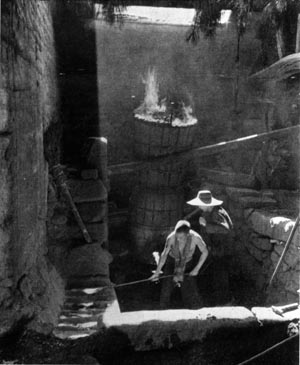 |
| Blast furnace in Jinzhai county, Anhui, photographed 1958. (All China makes iron and steel, Peking 1959). |
In September 1958 Mao Zedong visited a small traditional
steelworks in Anhui and was greatly impressed. This was no
doubt a plant of the Dabieshan
type, as shown here on the right. The blast furnace looks
simple, like something anyone could build and operate, and
in a newspaper interview he called for a mass campaign for
steel production. Ambition now reached new heights:
everyone – everyone
– should go out and produce iron and steel.
The propaganda magazines of the time were very
enthusiastic about the mass campaign, but the photographs
which accompanied the glowing reports tell a different
story. Anyone who was convinced by the two photographs
below must truly have been a true believer.

The underlying problem was that the small traditional blast furnaces were not in fact at all simple. Efficient operation required a feeling for sounds, smells, and colours which could only be acquired through a long apprenticeship. Experience in blast furnace operation was available only in places where production had never stopped, and these were in the poorest and most isolated regions of China. We know very little about what went on here, for these regions were avoided by both journalists and politicians.
| Rewi Alley, China’s hinterland – in the Leap Forward, Peking: New World Press, 1961. |
The exception was the New Zealand journalist Rewi Alley,
a true poverty-romantic who loved the hardships and
dangers of travel in the poorest parts of China. He seems
to be the only journalist – Chinese or foreign – who saw
traditional ironworks actually in operation during the
Great Leap Forward. He remarked proudly that it was the
poorest peasants who made the best steel, and he no doubt
believed that there were moral reasons for this, but
economic factors surely played an important role as well.
The poorest peasants were the most isolated, and therefore
those who had never stopped producing iron by traditional
methods – their comparative
advantage lay in iron production.
The problems can be seen fairly clearly in an otherwise
optimistic report at the beginning of December:
| Peking review, 2
December 1958, p. 7. |
The
relationship between popularization and elevation –
two aspects of the mass movement – is well illustrated
by the nationwide drive to produce iron by native
methods. At the start, when the masses had not yet
mastered the necessary technical knowledge and the
resources of iron ore were not known in detail,the
accent was on technique and the quantity of output.
That was the period of popularization. Now, more
than two months later, a huge number of workers are
familiar with the preliminary smelting technique, the
distribution of iron resources are better known and
the output has attained considerable proportions. The
time has ripened for elevation. The small and
native-style furnaces will, therefore, be gradually
led to form integrated iron and steel centres using
both native and foreign production methods. When this
is accomplished throughout the country, the movement
will be elevated to a higher stage.
It can be seen between the lines that the mass campaign
had been no sort of success. Now it was necessary to drop
the campaign while preserving appearances: the mass
campaign’s only purpose had been to ‘popularize’ iron
production, not actually produce anything.
| Peking review, 30
December 1958, pp. 6–8. |
A report at the end of the year from the State Economic
Commission tells more. Among the tasks for 1959 are the
consolidation of the small iron- and steel-production
units, and ‘manpower should be rationally arranged and
used’. The steelworks should integrate traditional and
modern methods, as has been done in Shangcheng and Macheng
Counties (both in the Dabieshan
region). Transport must be improved, so that the plants
can obtain the necessary raw materials and the pig iron
produced can be delivered on schedule to the larger
steelworks.
Four furnace types
In virtually everything that has been written about the
Great Leap in recent years, both academics and journalists
have hopelessly confused four different technologies:
- The small modern steelworks designed and promoted by
the Ministry of Metallurgical Industry. They were – and
are still – a valuable supplement to the large-scale
plants which were built with Soviet help. But the
decision in April 1958 to build an enormous number –
13,000 – of such works was undoubtedly a grave error,
and it is uncertain how many of these were actually
finished, or produced anything much.
- The largest of the traditional blast furnaces. In
regions where the technology was well known, such as Sichuan and Hunan, they
contributed to production both by supplying local needs
and by delivering pig iron to the larger steelworks.
- The very small traditional blast furnaces which were
documented and promoted by various provincial
governments in east China. These could no doubt supply
local needs, and some seem also to have delivered pig
iron to the modern plants, but with a danger of
widespread forest destruction. Their operation was
probably best in poor and isolated regions, and
transport from these to markets or other works must have
been difficult. We hear of large quantities of ‘useless’
iron produced in these furnaces which many years later
lay rusting; in all probability it lay unused more
because of transport difficulties than of inferior
quality.
- ‘Furnaces of the masses’ – the millions of small blast
furnaces which Mao Zedong on 29 September 1958 urged the
peasants to build. The campaign was a massive failure,
but it lasted only a couple of months.
| Yejin bao, 1958.52:
33–35 + 30. |
A technical article published in December 1958 surveys
production costs in a sample of 104 small ironworks in 12
provinces and municipalities. The average cost of one ton
of pig iron was 250 yuan,
with considerable variation, from 108 yuan at one works in
Shanxi to 852 yuan
at one in Liaoning. The article goes on to explain the
discrepancy under four heads: (1) regularity of blast
furnace operation: (2) political leadership, mobilization
of the masses, and technical advance (i.e. efficient use
of labour and fuel); (3) transportation costs; and (4)
management costs. It is concerned only with serious
ironworks which used traditional technology; the ‘furnaces
of the masses’ are never even mentioned. The survey found
that ‘management costs’, which in other contexts might
have been called the profits of the owner, varied between
5.3 and 30.2 percent of total cost.
Unfortunately, historians who have dealt with this period
seem virtually all to believe that the ‘furnaces of the
masses’ were the only type of furnace involved in the
Great Leap. Serious consideration of the technology would
without doubt lead to a better understanding of the
politics and economics of the time.
An example: Fenghuangwo
An
article
in the propaganda magazine China reconstructs for December
1959 reports on a small steelworks in the people’s commune
Fenghuangwo in Macheng County, Hubei (in Dabieshan). The peasants of
the commune, responding to the appeal in April 1958 for a
great leap forward, had built several hundred blast
furnaces of a traditional type which was well known here.
These produced 700 tons of pig iron and 100 tons of steel
(undoubtedly the low-carbon steel which is generally
called wrought iron).
By the end of the year, as has been noted above, it became
clear that there were problems with the small traditional
ironworks, and the government recommended that larger and
more modern works should be built on the basis of
experience with the traditional ones. The small modern
steelworks at Fenghuangwo went into operation in November
1958, still producing pig iron in small traditional blast
furnaces of 0.4 cubic metres, but with more modern
Bessemer converters and rolling mills to process it. This
was probably an excellent arrangement, at least in the
short run, but the use of charcoal in the blast furnaces
would either have limited production or threatened
environmental destruction. Toward the end of 1959 most of
the traditional blast furnaces had been replaced by very
small modern blast furnaces of 3 cubic metres, presumably
coke-fuelled. The reason for the use of modern blast
furnaces of such small size was perhaps that the ore was
ironsand, which can be difficult to use in larger furnaces
– though it is also quite possible that this ‘3’ is a
typographical error for (for example) ‘30’.
The article presents the Fenghuangwo steelworks as a
great success. One would hardly expect any other
evaluation in this context, but it seems reasonable to
believe in the success. Dabieshan had always been a region
whose comparative
advantage lay in iron production, and the technical
details in the report are clear enough to allow the
presumption that the works produced quite good steel for
local consumption.
| Communist China
1955–1959: Policy documents with analysis, cited
above, pp. 540–550;
also The
People’s Republic of China 1949–1979,
cited above, pp. 762–769. |
| Daniel
Houser, et al., ‘Three
parts natural, seven parts man-made: Bayesian
analysis of China's Great Leap Forward
demographic disaster’, Journal of
Economic Behavior & Organization,
69.2: 148-159 . |
Click
on any image to see it enlarged.

